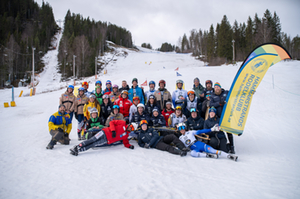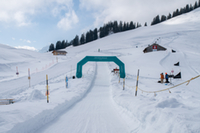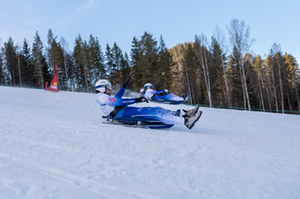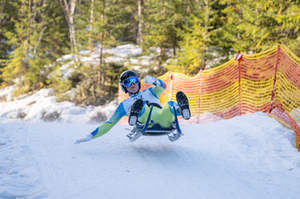The Future Workshop for Natural Track and Recreational Luge is working intensively on developing a new natural track luge and new race formats. The first test races took place in March in Grindelwald, Switzerland, and Hammarstrand, Sweden.

Group photo in Sweden
Berchtesgaden (FIL/02.04.2025) – 33 athletes (11 women/22 men) from 8 nations were invited to the tests. Among them were athletes from the FIL Natural Track Luge World Cup, world-class competitors from the ISSU sports luge sector, as well as ambitious recreational athletes from the host countries. Notable participants included world champion Evelin Lanthaler (ITA), vice world champion Riccarda Ruez (AUT), and Italian sports luge champion Silvia Runggatscher among the women, as well as luge legend Patrick Pigneter (ITA) and vice world champion Daniel Gruber (ITA) among the men.

The tests focused on the new “Alpine Luge” and new race formats, conducted both on a standard iced luge track and on a conventional ski slope with snowboard gates. Despite initial scepticism, the international test days were a great success. Patrick Pigneter commented: “We athletes are only familiar with our traditional sleds, so we are used to them. But we must be open to something new – that is the challenge.” The aim is to make natural track luge more accessible to more nations. For this reason, the “Alpine Luge” is less aggressive to ride, although the difference from the current sled is minimal. “The new luge has a broader range of use, from an ice track to spring snow on a ski slope. I’d compare the old luge to a racing bike and the new one to a gravel bike (a road bike with wider tyres). That’s why it will be easier for newcomers to access the sport – and that’s our goal.”
Classic Luge Tracks Will Remain
Iced luge tracks with wooden boards for World Cup races now only exist in South Tyrol and Austria. Preparing and maintaining these race tracks is labour-intensive, which discourages many potential organisers. Therefore, new race formats are being considered, including competitions on iced luge tracks without wooden barriers, as well as races on standard ski slopes. This would reduce the effort required for clubs and organisers while increasing the number of locations willing to host races.

The test-team is looking at the new "Alpine Luge" in Grindelwald
Patrick Pigneter explained: “In Grindelwald, we tested in a luge park at the foot of the Eiger North Face, a park that thrives on tourist luging. With just a few adjustments, the track was ready for us. In Sweden, we wanted to test the ‘Alpine Luge’ on an iced ski slope, similar to those used in the Ski World Cup. However, temperatures were at +10 degrees – now we know that the new material also works in slush.”

Patrick Pigneter (front) duelling Daniel Gruber
The course on the ski slope is defined by gates, similar to those used in ski cross or snowboard races. This also allows parallel races to be held with minimal effort. However, it is clear that “classic” luge races on ice tracks will continue to exist. “This was a test – it doesn’t mean this will be the future. I think everyone enjoys the development process, but we are not at the finish line yet. There is a lot of potential in luge, and we want to look ahead so that everyone benefits.”

Silvia Runggatscher (front) and Riccarda Ruez
Even with the new luge and on ski slopes, the best athletes will still be at the top, believes record-winner Pigneter, who ended his career with the World Cup final in March. “But this way, other nations will also have a better chance to prepare for races, which might lead to more mixed results.”
A glance at the results supports this assessment: at the test races on the Bussalp alone, there were three different female winners – Lisa Walch (GER), Evelin Lanthaler (ITA) and Daniela Mittermair (ITA). Among the men, winners included Stefan Federer (SUI), Christian Bauer (SUI) and Ziga Kralj (SLO).

Ziga Kralj flying on the "Alpine Luge"
When the “Alpine Luge” will replace the current race sled is still uncertain. “The development process has only just begun and is far from complete,” says Pigneter, who will continue to be part of the test team in the future.









